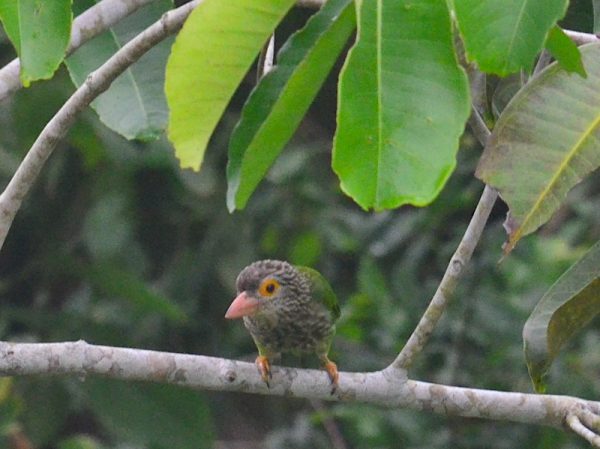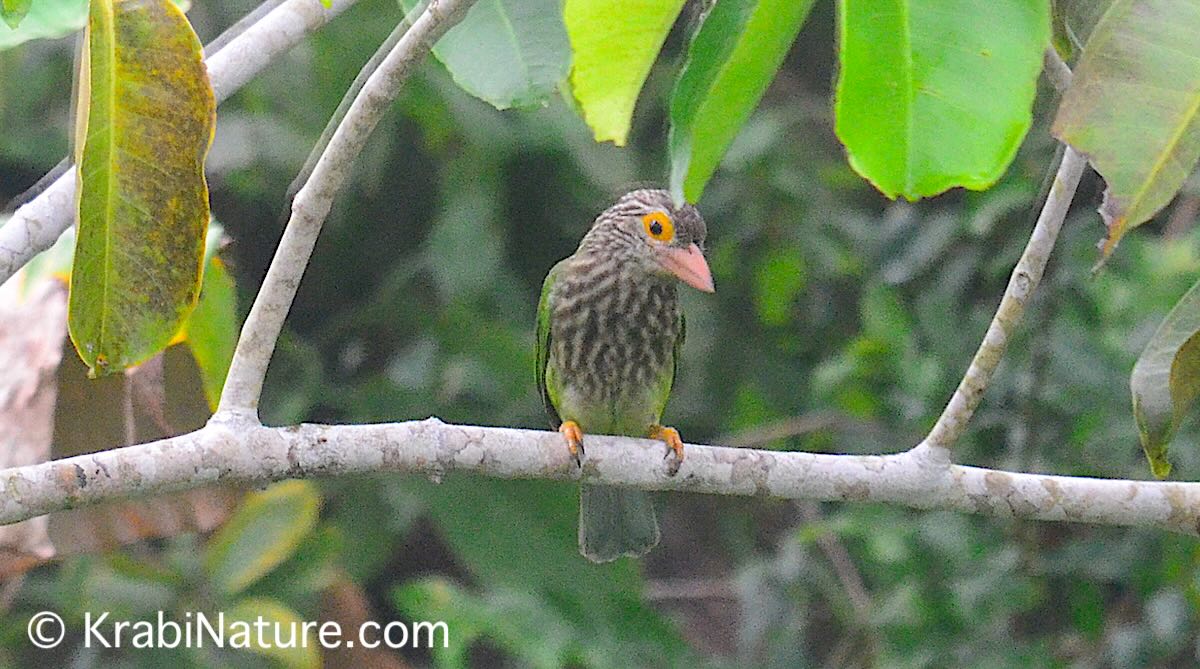Lineated Barbet – Krabi Birdwatching Field Guide
One of the most beautiful birds we have in Krabi and that you can see on birdwatching tours in the area is the LINEATED BARBET. It’s an odd name for such a beautiful green bird! Here is all the info we could collect about it, and more photos. 🙂
Book your Krabi Birding Tour in the Mangroves on a Boat here >
If you spend a few mornings around Krabi’s fruiting figs or village gardens, you’ll hear a steady kook-uk or tuk-tuk rolling through the trees. That is the Lineated Barbet – a chunky green fruit eater that blends into foliage and then pops into view with a pale streaky head and a big ivory bill. This page gives you everything a visiting birder needs to find it, recognize it, and actually understand what it is doing in Southern Thailand.
Quick ID – What to Look and Listen For
- Scientific name – Psilopogon lineatus
- Thai name – นกโพระดกธรรมดา
- Pronounced roughly nok phra-dok thammada – literally the common barbet in Thai. (Thai National Parks)
- Size and weight – about 27 to 30 cm from bill to tail and typically 115 to 205 grams – a solid, big-headed barbet with a thick bill. (Birds of Singapore)
- Colors and pattern – body rich green above and below with the belly paler; head, neck, and upper breast buffy to light brown with fine yellowish or whitish lines that give the “lineated” look; bill pale horn to yellowish and noticeably heavy. (Birds of Singapore)
- Voice – loud, repetitive, hollow barbet phrases that can carry a long distance through villages and forest edge. For reference calls and regional variation, check the Xeno-canto library before your outing. (Xeno-canto)
Range in Thailand and Where in Krabi
- The Lineated Barbet is widespread from the Indian subcontinent across mainland Southeast Asia into Thailand, where it is a common resident including the south. It tolerates human-modified habitats extremely well.
- Habitat you should target in Krabi
- Fruiting fig trees in towns and villages – watch roadside Ficus and mixed fruit trees around temples, schools, and quiet neighborhoods
- Forest edges, secondary woodland, rubber and oil-palm fringes, orchards, and parks – anywhere with mature trees and a fruit supply
- National parks and protected areas with lowland evergreen or mixed forest edge also hold them, but you will often get your best looks in town gardens when a fig goes off
Evidence from Singapore and Malaysia shows how at home this species is in urban green spaces, a pattern you will see repeated around Krabi.
Diet and Daily Living
- Primary food – fruit. Lineated Barbets are classic frugivores and important seed dispersers in Asian forests. They focus heavily on figs but will also take papaya, berries, and other soft fruit in gardens. Insects are taken more often when feeding chicks.
- What you will see in Krabi
- Birds making repeated visits to a fruiting fig in small loose groups, often sitting quietly inside the crown and only popping out to swallow a fruit whole
- In gardens they will drop into papaya trees and remain surprisingly confiding while feeding
- How often do they feed – frugivores like this tend to browse throughout the day, especially early morning and late afternoon when fruiting trees are busy. During the nestling stage adults increase trips to the cavity and shift the mix toward more animal food early in chick development, then more fruit as chicks grow. You can expect regular, repeated provisioning runs when chicks are in the hole and frequent short feeding sessions at fruiting trees outside the breeding cycle.
Breeding Biology
- Season in Thailand and nearby – breeding in Thailand peaks from about April to May, though across the species’ range they can breed from roughly January through July and sometimes raise two broods in a year.
- Nest site – a freshly excavated cavity in a dead or softened limb or trunk, occasionally a living branch or even a stump or standing log. Both sexes excavate and keep the chamber clean by removing fecal material during the season. Typical height a few meters above ground.
- Eggs per clutch – usually two to four glossy white eggs.
- Incubation – both parents share incubation. Reported incubation period is roughly two weeks, around 14 to 15 days. Some sources give a slightly longer window, but two weeks is typical for Asian barbets.
- Nestling period – chicks develop slowly for a piciform bird. Development in Lineated Barbet averages about 35 to 38 days in the nest before fledging. Parents gradually shift the diet from more insects early to more fruit later and carry waste out of the cavity.
- After fledging – fledglings may remain near the nest site for days to weeks, following adults to fruiting trees while learning the local food map. This is when gardens and fig avenues in Krabi can get noisy with family parties moving together.
Threat Level (Conservation)
- IUCN Red List status – Least Concern. The species is widespread and adaptable, though forest loss within parts of its range is noted. Population trend at a global scale is considered stable to slowly declining in places, with medium dependence on tree cover.
- Why it matters locally – because they swallow fruit whole and pass viable seeds, Lineated Barbets are part of the natural replanting crew in Southern Thailand. Protect fruiting figs and mature shade trees in villages and you will keep this bird visible and loud in Krabi.
Field Description

Book your Krabi Birding Tour in the Mangroves on a Boat here >
- Head and face – buffy to light brown with fine yellowish to whitish linear streaks across cheeks, throat, and upper breast that create the “lineated” look
- Eye ring and bare skin – pale to yellowish bare skin around the eye in many birds
- Bill – thick, conical, pale horn to yellowish – built for crushing fruit and chiseling nest holes
- Upperparts – rich leaf green that blends perfectly in canopy
- Underparts – paler, sometimes slightly yellow-washed belly with reduction of streaking compared to the chest
- Shape and posture – upright, woodpecker-like stance on thicker branches, usually perched quietly between feeding bouts
All of the above align with trusted regional accounts used by field guides and Singapore’s detailed species notes.
Behavior in Krabi
- Cryptic until the fig is ripe – they sit still and vanish into foliage, then suddenly you notice three birds where you thought there was one
- Vocal territory advertisement – repeated two-note phrases from a semi-exposed mid-canopy perch, often calling in alternating fashion with a nearby mate
- Cooperative cavity work – both birds drilling and then taking turns at the entrance to toss wood chips, then later arriving with food and removing fecal sacs during chick rearing
Tips to See them in Krabi
- Hunt the trees, not the birds – walk village lanes, temple grounds, and quiet resort gardens at first light and scan every fruiting fig or papaya
- Use the voice – if you hear the hollow, repeated barbet song, freeze and triangulate; the singer often sits a meter or two below the crown on a sturdy bough
- Bring patience and stay low profile – nesting birds can be stressed by crowds at a cavity. If you stumble on an active nest, watch from distance and keep it brief so the adults can work. Field notes from Southeast Asia show reduced approaches when too many observers gather.
Life History Summary for Checklisters
- Status in Krabi – common resident where trees and fruit are available
- Habitat menu – forest edge, secondary growth, orchards, rubber and oil-palm margins, parks, large gardens, fruit farms, village lanes with mature figs
- Diet – figs first, then a mix of other soft fruits and seasonally insects, especially for chicks
- Clutch size – two to four eggs per attempt
- Incubation – about 14 to 15 days by both parents
- Nestling period – about 35 to 38 days to fledging, cavity kept clean, diet shifts over time
- Season – peak April to May in Thailand, broader January to July possible, double-brooded in some places
- IUCN Red List – Least Concern (BirdLife DataZone)
Extra Natural History
- Seed dispersal powerhouse – in Asian forest networks, Lineated Barbets rank among the most versatile fruit eaters, recorded on dozens of plant species. They help move seeds across gaps, which matters in fragmented landscapes like mixed farms and forest edge in Krabi. (British Ecological Society Journals)
- Urban adapter – repeated observations show birds feeding on cultivated papaya and visiting city figs. This is why you can tick them from your hotel balcony when a fig tree is ripe.
Ethics on nests and playback
- Playback is rarely necessary with a species this vocal. If you use it, do so briefly and never at an active area
- If you locate a nest hole, give the adults space. Southeast Asian observations document hesitation to approach when human pressure is high. Your distance helps chicks get fed on time.
- We never see this species come closer than 30 meters from our balcony at our home where we see them often in the palms.
Sources
- Thai common name and basic species entry – Khao Kheow Open Zoo resource lists the Thai name and gives a concise overview for Thailand.
- Conservation status and range – BirdLife DataZone is the official IUCN authority for birds and details habitat dependence and elevation spread for Psilopogon lineatus.
- Size and plumage detail – consolidated from regional field treatments and Singapore’s species account used by many Southeast Asia birders.
- Breeding timing, clutch, and incubation – Thai zoo reference for season and clutch size, with additional breeding-window and incubation figures from specialist barbet resources.
- Nestling period and parental care – detailed natural-history write-up from the Lee Kong Chian Natural History Museum notes slow development and double brooding.
- Feeding behavior and urban fruit use – the Bird Ecology Study Group documents fig and papaya feeding in urban contexts that mirror what you will see in Southern Thailand.
- Role as a frugivore in ecosystems – research on large frugivores and species interaction networks highlights Lineated Barbet’s broad fruit list and seed dispersal role.
Last Note for Krabi Birders
You do not need pristine rainforest to find this bird. You need fruit, mature trees, and ten minutes of patience. Work those village figs at dawn, trust your ears, and scan methodically. When the crown erupts with green shapes and heavy bills, that is your moment.
We find them most often in large palm trees – whether a plantation, or growing naturally somewhere.
The Lineated Barbet is one of Krabi’s most reliable lowland specialties for visitors because it lives right alongside people. Learn the voice, respect the nests, and you will get close, clean views and easy photos when the fruit is ripe.



